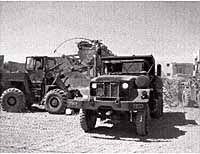| Members of the 1457th Engineering Battalion excavate the bombed out are in seach of the remains of Saddam Hussein. The operation required a lot of man power, as well as heavy machinary. |
Upon arrival in the theater of operations, the 1457th Engineering Battalion, with Company A hailing from Price, was assigned to the 1st Armored Division’s Engineer Brigade. The Engineer Brigade welcomed immediately began assigning them missions.
The highest priority mission in recent days was the excavation of a bombed out building where the remains of Saddam Hussein were thought to be located. It was a battalion effort involving 32 M817 five ton dumps trucks, two, two and a half yard loaders, and one D-7 bulldozer. Sixty four combat engineers and 10 equipment operators worked 24 hour-a-day operations at the excavation site.
The debris was hauled approximately 14 kilometers to a “sift site” for processing. A two and a half yard loader, and a SEE tractor were used to spread removed debris for examination by forensics experts. Working under combat conditions the battalion moved an average of 398 cubic yards of material a day from the excavation site to the sift site.
Conducting operations 24 hours a day under tight security, engineer leadership was challenged by the difficult navigation of heavy equipment through crowded and often unsettled streets. Equipment maintenance, and soldier sleep and rest plans also proved challenging.
During the operation, security was provided by the 2nd Brigade Combat Team of the 1st Armored Division, while convoy escorts were provided by the 93rd Chemical company and 18th MP Brigade.
The excavation process took five days to complete. During the removal operations 1,992 cubic yards of material were removed through 498 dump truck loads for processing.
Members of the battalion then assisted the CID/forensics team to spread and sift the material for human remains over an additional seven day period. The mission was directed and over watched to ensure professionalism and precision.
Lessons learned from the mission include the following:
• Keep convoys small (10 vehicles or less when moving through urban areas).
•Ensure that soldiers on the ground have some basic skills and rules of engagement for dealing with the media. Personnel were overwhelmed with national and international media throughout the entire project.
•The use of a battalion TAC CP for keeping solid command and control for a high profile mission which was isolated from the battalion’s main command post.
•The use of the smaller five ton dump trucks to provide mobility in the built up areas of the city. The five ton dump has a more durable bed than the 20 ton dump, and though its smaller payload required more trips, the heavy rubble removal didn’t cause damage to the truck bed.
The 1457th Battalion were successful in their mission and are now working on other high profile projects like the clean up and repair of the Baghdad Zoo.

